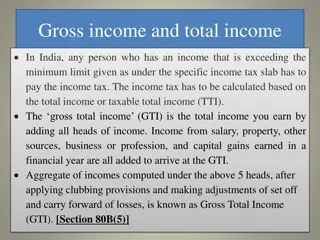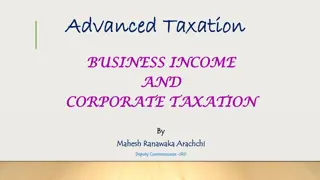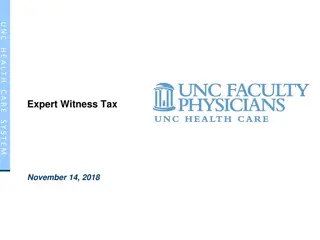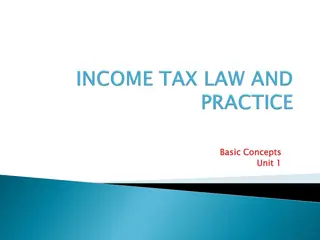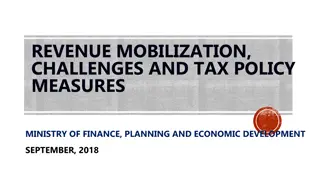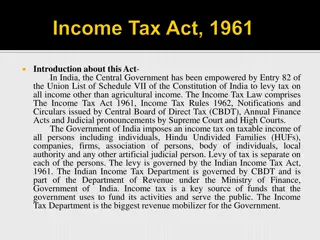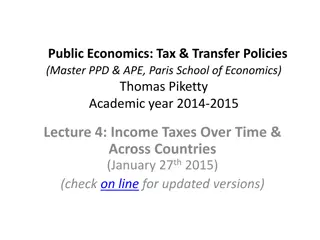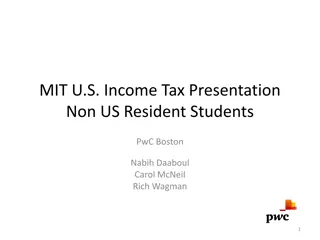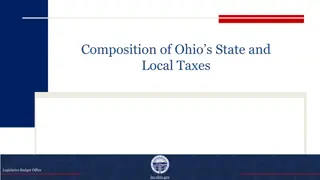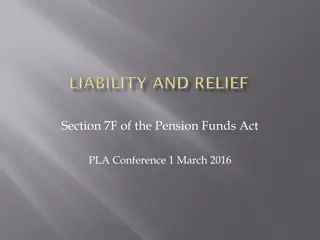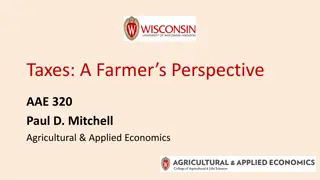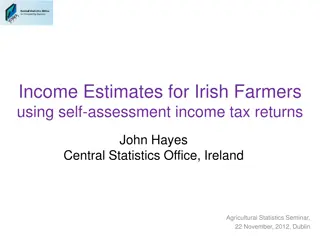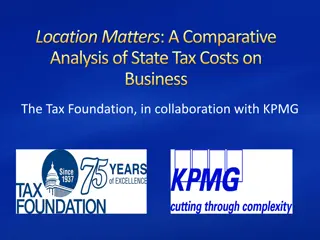
Fiduciary Income Tax Planning Tips and Rules 2014
Learn fiduciary income tax planning tips and rules for 2014, covering topics such as allowable expenses, deferring income, distribution deductions, estate tax deductions, and more. Understand Form 1041 basics and estate and trust income tax rates to effectively plan your taxes.
Download Presentation

Please find below an Image/Link to download the presentation.
The content on the website is provided AS IS for your information and personal use only. It may not be sold, licensed, or shared on other websites without obtaining consent from the author. If you encounter any issues during the download, it is possible that the publisher has removed the file from their server.
You are allowed to download the files provided on this website for personal or commercial use, subject to the condition that they are used lawfully. All files are the property of their respective owners.
The content on the website is provided AS IS for your information and personal use only. It may not be sold, licensed, or shared on other websites without obtaining consent from the author.
E N D
Presentation Transcript
Fiduciary Income Tax Planning Tips Mary Parente, CPA, CGMA Partner Trust and Estate mparente@odpkf.com May 16, 2014
Topics Well Cover Current Tax Schematic Allowable Expenses Deferring Income/Accelerating Deductions Choice of Fiscal Year IRC Section 645 election 65 Day Election Final Year Basis of Assets Transferred/Sold Estate Tax Deduction (IRD) DRD Double Deduction New on the Horizon 2
General Rules Filing a Return Required if Gross Income > $600 Basics of Form 1041 Taxation Gross Income $ xx,xxxx Less: Deductions ( xx,xxx) Less: Distribution Deduction ( xx,xxx) Less: Estate Tax Deduction ( xx,xxx) Less: Exemption ( xxx) Equals Taxable Income $ xx,xxx TAX XXX 3
General Rules Distribution Deduction Function of Distributable Net Income Equals Taxable Income Reported by Beneficiaries via K-1 Triggered by distribution from Estate Distributable Net Income Term of Art Yardstick - limits the distribution deduction and the amount and character of income attributable to residuary beneficiaries 5
Estate and Trust Income Tax Rates (2014) Taxable IncomeIncome Tax RateL/T Capital Gain Rate Under $2,500 15% 2,500 - 5,800 25% 5,800 8,900 28% 8900 12,150 33% Over 12,150 39.6% (+3.8% Surtax) 0 15% 15% 15% 20% (+ 3.8% Surtax) 6
Imposition of 3.8% NII Tax for Estates Lower of: Undistributed net investment income (NII), or AGI in excess of $ 12,150 NII (net investment income) includes: capital gains, interest, dividends, passive income NII excludes: Qualified retirement income (IRA, 401K, etc.) Active business income Compare to 3.8% for Individuals Single Taxpayer AGI exceeds $ 200,000 Married Filing Joint Return AGI exceeds $250,000 7
General Rules of Estate Income Taxation Income Rules same as individual for reporting interest, dividends, tax exempt income, capital gains, rents, partnership K-1 Deductions Estates entitled to many of same deduction as individuals Allocation to tax exempt income Direct vs. indirect methodology Exemption $ 600 8
Types of Deductions Interest Same as individual Personal interest not deductible Qualified Residence interest is deductible Interest arising from tax deficiencies not deductible Investment Interest Expense is deductible Taxes State income taxes with respect to income earned by estate State Estate, Gift, or Inheritance Tax not deductible 9
Types of Deductions Administration Expense Fiduciary Fees (line 12) Attorney and accounting (line 14) Other deductions not subject to 2% (line 15a) Costs incurred during administration of estate that would not have been incurred if the property were not held in estate, for example Probate costs, Investment fees Appraisal costs Subject of substantial controversy 10
Types of Deductions FINAL REGS ISSUED 5/9/14 Applies to tax years beginning after issue date Retains the requirement that certain fees be unbundled Deductible to the extent it exceeds the fee generally charged to an individual investor, where the excess is attributable to an unusual investment objective of the estate or to the need for a specialized balancing of the interest of various parties such that a reasonable comparison with individual investors would be improper. Specifically includes appraisal fees and other probate fees as not subject to 2% 11
Types of Deductions Deductions Subject to 2% Deductible to the extent they exceed 2% AGE Similar to individuals but calculated differently Interrelated calculation best left to software Examples: Investment advisory fees, Maintenance and preservation expenses 12
Special Deduction Income Distribution Deduction Does not exist in other entities subject to Federal Taxation (except trusts) Based on the Distributable Net Income of the Estate Computation on Form 1041, page 2, Schedule B (illustration) Mechanism to determine income available for distribution Excludes capital gain Includes tax exempt income Source of K-1 to beneficiaries Usually residuary beneficiaries receive K-1 Beneficiaries who receive specific bequests excluded since they do not share in the income/expense of estate 13
Planning Opportunities Choosing Fiscal Year Option to report on any month end Caveat 1st year cannot be more than 12 months Used to defer income, e.g. 11/30/13 estate year end - removes 12/31/13 K-1 (from a flow through entity) from estate and defers to 11/30/14 estate income tax return Fiscal year beginning 2/1/14 ending 1/31/15 defers income (assuming distribution to beneficiary) reporting of beneficiary to 2015 Inclusion of Revocable Trust with Estate Income Tax Return a.k.a. Section 645 Election Ability to use fiscal year for trust activity Reduces administrative burden of filing two income tax returns Lasts two years beyond decedent s DOD (longer if filing 706) 15
Planning Opportunities 65 Day Election Ability to treat any distribution made within first 65 days of estate tax year as having been made in the prior year Beneficial to beneficiaries in lower tax brackets than estate (probably every beneficiary) Checkbox election Can reduce surprise income in the estate Final Estate Income Tax Return Defer expenses that exceed income to final year Why? Final year excess deductions pass out to beneficiaries Capital losses and NOL s also pass out to beneficiaries Suspended PAL s (if any) increase basis of assets distributed to beneficiaries 16
Planning Opportunities Basis of Assets Stepped up on Date of Death (or Alternate Valuation Date) Rarely results in significant gain ask the question if not the case Exception 2010 estate electing modified carryover and holding period Long-Term Gain treatment regardless of when purchased by decedent Communication with broker a must to correct basis on all assets sold or eventually distributed to beneficiaries!!!!!! Sale of personal residence capital loss treatment 17
Planning Opportunities Estate Tax Deduction for (IRD) a.k.a 691( c ) deduction or the double tax Less frequent application due to increased estate exemption amount Applies to assets that do not receive a step up at death (or IRD assets) included in estate return and taxable when received by the estate (or directly by beneficiary) Wages of decedent IRA s, 401K Dividends declared prior to death but paid after death Installment Note Deduction of estate tax paid against income included on fiduciary or beneficiary s income tax return. Must be communicated by estate tax preparer to professionals preparing the fiduciary income tax return and the beneficiary income tax return. 18
Planning Opportunities DRD (Deduction in Respect of Decedent) Double Deduction Benefit (Form 706 and Form 1041) Must be a liability at decedent s DOD Can be determinable with certainty and will be paid Decedent was liable Examples: Business Expenses Interest Expense Taxes Income and Real Estate Investment Expenses % Depletion 19
Planning Opportunities Estimated Taxes Estimated taxes not required until two years after estate commences (2015 for an estate beginning in 2013) In final year of estate, 1041-T to allocate to beneficiaries (must be filed within 65 days of year-end); otherwise will need to file for refund. 20
Planning Opportunities Allocation of Administration Expenses to form 706 vs. Form 1041 Strategy Allocate expense to return with higher marginal tax rate Estate Tax Income Tax Prior to 2013 45% 35% 39.6% + 3.8% Beyond 2013 40% Result: More Difficult Now 21
Questions Is marital/charitable deduction reduced? Will it cause a taxable estate? Is Net Investment Income Tax applicable? Are administration expenses subject to 2%? Sufficient income to benefit from deduction? Is there a state income tax? Is there a state death tax ? Amount of exempt income? See comparison chart 22
Distributions in Kind General rule no gain or loss recognition carryover basis to beneficiary Special Election [643 ( e) election] to treat distributed property as sold at FMV on date of distribution and recognize gain at estate level. Will apply to all assets distributed during that year Loss recognition not allowed since transaction is treated as a sale to a related party and not recognized. Exception loss on funding a pecuniary bequest can be recognized. Used when estate has large capital losses or other losses which will not be used. Shouldn t be used if beneficiary in lower tax bracket, asset will be held by beneficiary for a long period, or will be held by beneficiary until death. 24
Thank You Questions? 25




